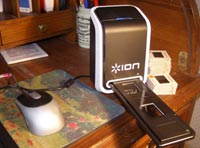Converting Slides to Digital Images by Bruce Preston Author’s Note: This article best appreciated if read while listening to Paul Simon’s Kodachrome. By my estimate, over the last 40 or so years, I have taken about 6,000 slides. Topics include such things as family get-togethers, Formula 1 and Can-Am races at Watkins Glen, SCCA races at Lime Rock Park, bike tours in Vermont, the U.K, Western Europe, and steam locomotives in Colorado, Vermont, Pennsylvania and New Jersey. For all of these I much prefer the color fidelity and permanence of slides over prints. Unfortunately, slides also require either setting up a projector and screen or using a hand-held viewer, and don’t easily lend themselves to sharing. Years ago I had a Polaroid SprintScan 35 film scanner, but it required a SCSI adapter card and Polaroid went under without delivering drivers for Windows 2000 or XP. It was also somewhat slow taking about 2 minutes per scan. I will grant you that it delivered high quality images. My brother in law has scanned a few slides using a flatbed scanner with a light box cover, but the resolution was not great. It was acceptable for distributing by e-mail or posting on a web page, but not satisfactory for full screen viewing.
Slides 2 PC comes bundled with ArcSoft’s Photo Impressions 6, a consumer-friendly image capture/editing/cataloging program commonly bundled with digital scanners and cameras. The scanner appears as a TWAIN device, I happen to prefer the free (for personal use) IrfanView as I have used IrfanView for years. http://www.irfanview.com/ One thing I disliked about the ArcSoft package was its insistence upon loading an always resident module. I don’t know if the device will work with a Mac – next time Scott is around with his Mac we’ll see if it recognizes it. Since it is a TWAIN device there is a good chance as long as your bring your own software. Operation is simple; I’ll describe the process when using IrfanView. Select the TWAIN source from the FILE menu, and then select ACQUIRE/BATCH. The first dialog box asks for a target folder, a root filename, the starting number and the number of digits. I created folder “\My Documents\My Pictures\VBT Tours\1972” as the folder, “VBT_” as the filename root, 1 as the starting number, and 3 as the number of digits. I clicked OK and the scanner loaded with a real-time preview. In this case of a blank white area since I hadn’t loaded a slide. Note that since it is a video camera rather than a moving scanner mechanism there are essentially no moving parts within that can get out of calibration. If you use Photo Impressions 6 as part of start up you get a configuration screen for the scanner where you may select image size, color depth, JPEG or TIFF, and specify whether you are scanning transparencies (slides), color or B/W negatives. IrfanView just uses the defaults of JPEG at 24 bit color depth. As far as speed is concerned, on this lazy Sunday afternoon I scanned 60 slides in 33 minutes without rushing. This included taking the slides out of the Bell & Howell ‘Slide Cube’ and reloading them. I have yet to go into the JPEGs to rotate the images that need to be turned from landscape to portrait orientation – IrfanView can do that with a single key-press. For those who like spec sheets:
More information at http://www.ionaudio.com/slides2pc Sources – I did a little web searching while wrapping up this article. The average eBay auction over the last 60 days closed at $85 including shipping. J&R has it for $79.99 plus shipping which I suspect will put it right about $85. If you like rolling the dice, from time to time a factory refurb shows up on eBay at about $65. If you have many slides or negatives that you’d like to convert to digital, give this unit some thought. I’m very happy with it. |
 Click Here |
 |
 |
DacsGear!
|
 A few months ago I discovered Ion Audio’s “Slides 2 PC” 35 mm Slide and Film Scanner. It is a nifty compact device that consists of housing containing a fixed-focus USB 2.0 camera, a white-balanced light source and a pair of carriers – one that can hold 3 mounted 35 mm slides, the other for 6-exposure 35 mm negative strips. System requirements are minimal – Windows XP or Vista, and a USB 2 port. (If you only have USB 1.1 you will need to add a USB 2 card to your desktop or get a USB 2 PCMCIA card for your notebook. I tried it on my old notebook and the driver refused flatly stating that it needed USB 2.)
A few months ago I discovered Ion Audio’s “Slides 2 PC” 35 mm Slide and Film Scanner. It is a nifty compact device that consists of housing containing a fixed-focus USB 2.0 camera, a white-balanced light source and a pair of carriers – one that can hold 3 mounted 35 mm slides, the other for 6-exposure 35 mm negative strips. System requirements are minimal – Windows XP or Vista, and a USB 2 port. (If you only have USB 1.1 you will need to add a USB 2 card to your desktop or get a USB 2 PCMCIA card for your notebook. I tried it on my old notebook and the driver refused flatly stating that it needed USB 2.)